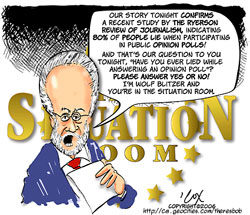Do Rob Ford reporters have a transparency problem?
Recent Ontario Press Council hearings called out the use of anonymous sources in the coverage of Toronto's mayor, leaving readers questioning journalism’s trustworthiness

A scene from the Ontario Press Council hearings on September 9, 2013. (Photo Credit Emma Jarratt)
On a summer afternoon in August 2011, Globe and Mail investigative reporter Greg McArthur sent an email to his editor with the subject line, “Ideas.” Inside, he suggested: “A portrait of Rob Ford as a young man—who is Rob Ford, really?” Alongside freelancer Shannon Kari, McArthur called Ford’s high school classmates and hunted down yearbooks. “I was a little naïve about the willingness of the people who knew Ford to talk,” says McArthur. But the sources who did speak quickly changed the story. “Robby was a good kid,” one source told him. So Doug and Randy became the focus of the story.
The resulting story, titled “The Ford Family’s history with drug dealing,” used 10 confidential sources and ran on May 25, 2013. In early September, the Ontario Press Council (OPC) heard a complaint that argued the story relied too heavily on unattributed information. On October 16, citing a handful of Supreme Court decisions that said it is occasionally responsible to rely on confidential sources, the council dismissed the complaint, ruling that the Globe acted ethically and responsibly. It said the same of the Toronto Star and its “Rob Ford in ‘crack cocaine’ video scandal” story, which had also generated complaints to the OPC. But the council concluded that “the robust and extensive journalistic standards that good newspaper reporting should meet are not well known or understood by the public.” It suggested the onus is on journalists to communicate what those standards are.
If the public doesn’t understand journalism, it also doesn’t have much confidence in it. A 2012 Ipsos poll revealed only 31 percent of Canadians trust journalists. The Globe and Star used confidential sources responsibly, but they didn’t communicate why those sources were credible or neglected to fully explain why the papers granted them confidentiality. If journalists intend to keep—or win back—the public’s trust, they must make sure that if readers can’t know the sources’ identities, they’d better know everything else.
* * *
On the evening of May 16, Star investigations editor Kevin Donovan was coaching a girls’ rep team. Shortly after 8:28, he received an email telling him that American gossip website Gawker had broken the story about the alleged video of Rob Ford smoking what appeared to be crack cocaine—a video Donovan and city hall reporter Robyn Doolittle had viewed three times. Then, a terse message from Star editor-in-chief Michael Cooke: “Get in.”
Donovan rushed back to the newsroom and, with his colleagues, made 14 attempts to get a response from the mayor—by phoning Ford, knocking on his front door and contacting his chief of staff and press secretary. Only the mayor’s lawyer replied, calling the claim “false and defamatory.” Donovan and Doolittle quickly wrote the story before meeting with Cooke, Star lawyer Bert Bruser and two other senior editors to scrutinize it line by line. At 11:07 p.m., it went online.
The Star reporters later learned the man who’d shown them the video was Mohamed Siad, an alleged drug and gun dealer who was later stabbed several times in jail after his arrest in a June police raid. “I know he doesn’t sound like the greatest source in the world,” Donovan says now. But a number of other confidential sources told them they’d also seen the mayor smoking crack cocaine, which made them more comfortable running the story. “They’re confidential because they’re afraid they’re going to be beaten up or killed.”The story never mentioned those sources or their safety concerns. Doolittle says it shouldn’t have to, because she and Donovan saw the video. “This is not a story that relies on confidential sources,” she says. “The source is the video.” But, she adds, the public is increasingly unsatisfied with news it can’t see itself.
The use of those sources came out in media interviews—collectively, Donovan and Doolittle did roughly 100 in the week after the story—and at the OPC hearings, but for some readers that was too late. “A lot of people had already made up their minds,” says OPC executive director Don McCurdy. “The Fords are very polarizing political figures. People had already taken sides.” In other words, Ford critics tended to accept the legitimacy of the stories while Ford Nation refuted them.
Like many of the Star’s sources, McArthur’s wouldn’t speak on the record. He lists the reasons: fear of speaking out against the mayor’s family, of criminal charges, of an inability to travel, of a reaction from the system supplying the drugs, of reputational damage because of involvement, whether as traffickers or consumers. In the Globe’s 4,177-word story, only one line—“Upon being approached, the sources declined to speak if identified, saying they feared the consequences of outing themselves as former users and sellers of illegal drugs”—explains why the paper gave the sources anonymity. A similar sentence appears in editor-in-chief John Stackhouse’s letter justifying the decision to publish the story. “If I could do it over again, I would lay out all the different reasons we were given,” says McArthur. “It’s sort of an aside, so you want to get back to the narrative.”
He and others, like McCurdy, suggest putting information about the sources in a sidebar or editor’s letter in the future, as long as those details are provided at the same time as the story and not afterward. “People read the story and move on,” says McCurdy. “Sometimes it just takes a couple more sentences.”
* * *
Toronto’s journalism world is packed into the white-walled Sears Atrium at Ryerson University on Monday, September 9. Doolittle and Donovan chat with a cast of Star editors. Nine television cameras line the room’s north wall. The 100 people in attendance sit with smartphones out and TweetDecks open, ready to report the minutiae of the OPC hearings.
Mid-afternoon, Connie Harrison, who brought a complaint against the Globe before the council, leans into a microphone on the table in front of her. She questions the story’s sources, their motivations and what they feared would happen if they spoke on the record. “The only right thing to do is to have one person come out and say, ‘I am willing to go on the record,’” she tells the council. “Burn the source.”
McArthur is disappointed with that suggestion. “Anonymity is really the main tool in our toolbox to get people to talk. So to be seen as someone who would be willing to burn a source, I might as well decide I’m going to go sell insurance.” Still, he concedes he and the Globe haven’t done a good enough job at communicating why the sources were confidential. At the hearing, Stackhouse delivers a speech and McArthur answers questions, detailing every reason for their sources’ anonymity. Next time, he’ll put those reasons in the story.
Update: Due to an error, a previous version of this story was posted. This is the correct version.















